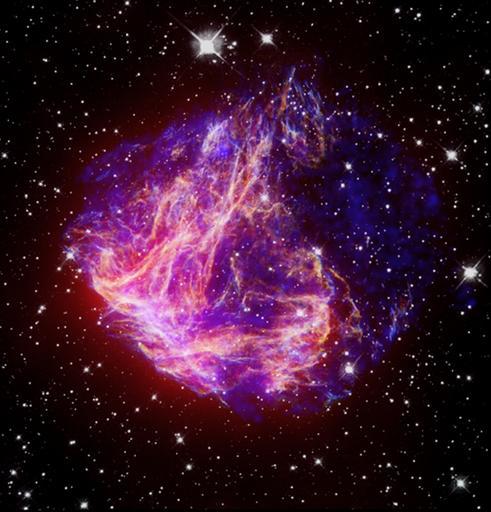MAKE A MEME
View Large Image

| View Original: | N49:_Stellar_Debris_in_the_Large_Magellanic_Cloud.jpg (2320x2420) | |||
| Download: | Original | Medium | Small | Thumb |
| Courtesy of: | www.flickr.com | More Like This | ||
| Keywords: smithsonian institution smithsonianinstitution n49 chandra celestial cloud xray gas universe hubble stellar supern stars night light colors sky starsnightlightcolorssky smithsonian astrophysical observatory smithsonianastrophysicalobservatory Description: In Chandra's X-ray data, N49 shows million-degree gas in its center (blue), while Spitzer reveals much cooler, infrared-emitting gas at the remnant's outer regions (red). Unique filamentary structure observed in optical light by Hubble (white & yellow) sets N49 apart from most other supernova remnants that appear roughly circular in visible light. When the multiwavelength data is combined, it appears to confirm the idea that this supernova remnant is expanding into a denser region to the southeast, which would cause its asymmetrical shape. Creator/Photographer: Chandra X-ray Observatory NASA's Chandra X-ray Observatory, which was launched and deployed by Space Shuttle Columbia on July 23, 1999, is the most sophisticated X-ray observatory built to date. The mirrors on Chandra are the largest, most precisely shaped and aligned, and smoothest mirrors ever constructed. Chandra is helping scientists better understand the hot, turbulent regions of space and answer fundamental questions about origin, evolution, and destiny of the Universe. The images Chandra makes are twenty-five times sharper than the best previous X-ray telescope. NASA's Marshall Space Flight Center in Huntsville, Ala., manages the Chandra program for NASA's Science Mission Directorate in Washington. The Smithsonian Astrophysical Observatory controls Chandra science and flight operations from the Chandra X-ray Center in Cambridge, Massachusetts. Medium: Chandra telescope x-ray Date: 2001 Persistent URL: chandra.harvard.edu/photo/2006/n49/ Repository: Smithsonian Astrophysical Observatory Collection: Supernovas and Supernova Remnants Collection Gift line: X-ray: NASA/CXC/Caltech/S.Kulkarni et al.; Optical: NASA/STScI/UIUC/Y.H.Chu & R.Williams et al.; IR: NASA/JPL-Caltech/R.Gehrz et al. Accession number: n49 Description: In Chandra's X-ray data, N49 shows million-degree gas in its center (blue), while Spitzer reveals much cooler, infrared-emitting gas at the remnant's outer regions (red). Unique filamentary structure observed in optical light by Hubble (white & yellow) sets N49 apart from most other supernova remnants that appear roughly circular in visible light. When the multiwavelength data is combined, it appears to confirm the idea that this supernova remnant is expanding into a denser region to the southeast, which would cause its asymmetrical shape. Creator/Photographer: Chandra X-ray Observatory NASA's Chandra X-ray Observatory, which was launched and deployed by Space Shuttle Columbia on July 23, 1999, is the most sophisticated X-ray observatory built to date. The mirrors on Chandra are the largest, most precisely shaped and aligned, and smoothest mirrors ever constructed. Chandra is helping scientists better understand the hot, turbulent regions of space and answer fundamental questions about origin, evolution, and destiny of the Universe. The images Chandra makes are twenty-five times sharper than the best previous X-ray telescope. NASA's Marshall Space Flight Center in Huntsville, Ala., manages the Chandra program for NASA's Science Mission Directorate in Washington. The Smithsonian Astrophysical Observatory controls Chandra science and flight operations from the Chandra X-ray Center in Cambridge, Massachusetts. Medium: Chandra telescope x-ray Date: 2001 Persistent URL: chandra.harvard.edu/photo/2006/n49/ Repository: Smithsonian Astrophysical Observatory Collection: Supernovas and Supernova Remnants Collection Gift line: X-ray: NASA/CXC/Caltech/S.Kulkarni et al.; Optical: NASA/STScI/UIUC/Y.H.Chu & R.Williams et al.; IR: NASA/JPL-Caltech/R.Gehrz et al. Accession number: n49 | ||||